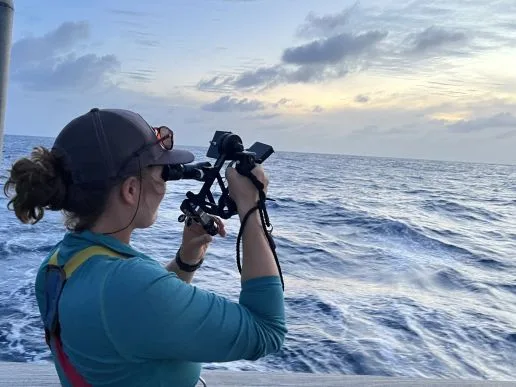Programs Blog
Dawn Watch in the North Pacific

April 27, 2023
Josefine Wallace, B watch, deckhand
Ship’s Log
Noon Position
08° 37.4’ N, 150° 17.7’ W
Ship Heading
340°
Ship Speed
5 knots
Taffrail Log
2278 nautical miles
Weather / Wind / Sail Plan
Sailing on a starboard tack under four lowers and jib topsail with shallow reef in the main
Description of location
Northern Equatorial waters
0100 this morning found B watch taking over from A watch, under a sky of stars and an ENE breeze. We divvied up positions – two to lab, one to helm, one to plot our position. I went to lookout, forward on the bow, clipped in to the forestay and riding the swell. I scanned the horizon – dark sky, dark sea – looking for deeper shadows that may herald a squall, or for the lights of other ships ghosting along the horizon. The bow sliced through waves, sending spray cascading over the foredeck, illuminated green by the starboard running light. I was glad for my foul weather gear jacket, glad for the easing of the temperature that allowed me to wear the jacket without breaking a sweat. Hundreds of miles from land, perched on a pitching deck in the middle of the night, I caught myself thinking about a cup of coffee and idly wondering what breakfast would be; not for the first time I marveled at human adaptability.S308 students and staff have been aboard for almost a month now, immersed in a new ship, new routines, new terminology, new geography, new weather patterns. Consider the breathtaking difference between a classroom in Wood’s Hole (or a hospital rotation in Wenatchee, WA, which is where I came from), and being a watch stander on a sailing ship halfway across the Pacific Ocean. But at this point we are settled in. The new has become familiar, the nerve-wracking has become routine. Between watches we go to class on the quarterdeck, we do chores and fret over dishes, we spend time with friends. This is something I love about sailing on ships like Robert C Seamans – the mundane reproduced in this austere and alien setting, the routine juxtaposed with the ever-changing sea.My nightly routine involves wielding a sextant and shooting the stars at twilight (weather permitting), a practice that still blows me away with its simplicity. Imagine measuring an angle to some stars and planets rotating across the sky, and with a few calculations (ok, quite a few calculations if done by hand), coming up with the ship’s precise location! I’ll sign off now to go participate, and with any luck will plot a celestial fix on the chart by 1900 tonight.Wishing a very happy birthday to our student Olivia, and also to my mom – mom, I am safe, I am happy, and I’m missing you!Josefine Wallace, B watch, deckhand
https://sea.edu/wp-content/uploads/2023/04/blog-photo-1-April-27_small.jpg
Recent Posts from the Ships
- Ocean Classroom 2024-A collaborative high school program with Proctor Academy
- Collaborations and Long-term Commitments: SEA’s Caribbean Reef Program Sets a Course for Coastal Programs that Compliment Shipboard Experiences.
- Sea Education Association students prepare for life underway using state of the art nautical simulation from Wartsila Corporation.
- SEA Writer 2022, Magazines From the Summer SEA Quest Students
- Technology@SEA: Upgrades Allow Insight into Ocean Depths
Programs
- Gap Year
- Ocean Exploration
- High School
- Science at SEA
- SEA Expedition
- SEAScape
- Pre-College
- Proctor Ocean Classroom
- Protecting the Phoenix Islands
- SPICE
- Stanford@SEA
- Undergraduate
- Climate and Society
- Climate Change and Coastal Resilience
- Coral Reef Conservation
- Marine Biodiversity and Conservation
- MBL
- Ocean Exploration: Plastics
- Ocean Policy: Marine Protected Areas
- Oceans and Climate
- Pacific Reef Expedition
- The Global Ocean: Hawai'i
- The Global Ocean: New Zealand